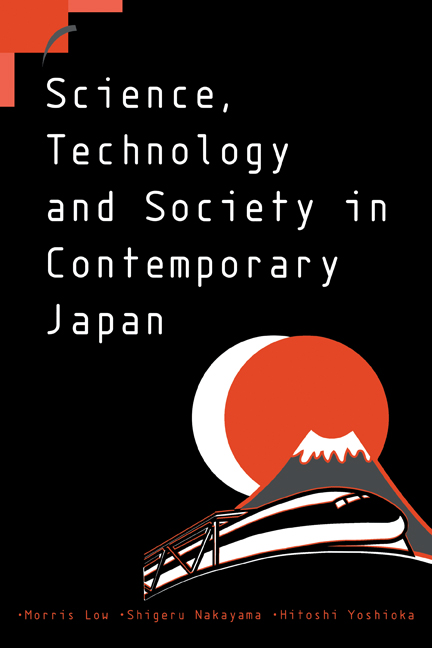Low, Morris, Shigeru Nakayama, and Hitoshi Yoshioka. 1999. “Technology versus Commercial Feasibility: Nuclear Power and Electric Utilities.” In Science, Technology and Society in Contemporary Japan, 66-81. Cambridge: Cambridge University Press.
 This article is a chapter of a book coauthored by Morris Low, Shigeru Nakayama, and Hitoshi Yoshioka on the contemporary history of science and technology in Japan, published in the same year as Yoshioka’s book 原子力の社会史 (A Social History of Nuclear Power). This chapter is a condensed account of the history of nuclear power in Japan, presumably authored primarily by Yoshioka.
This article is a chapter of a book coauthored by Morris Low, Shigeru Nakayama, and Hitoshi Yoshioka on the contemporary history of science and technology in Japan, published in the same year as Yoshioka’s book 原子力の社会史 (A Social History of Nuclear Power). This chapter is a condensed account of the history of nuclear power in Japan, presumably authored primarily by Yoshioka.
Covering the early history of electric power before the war, the beginning of the atomic energy program in the 1950s, the introduction of reactors in the 1960s, and the fast breeder program up to the 1990s, this chapter examines the complex relations between the public good and private interests in technology and its industrial applications. While the power industry has been dominated by the private sector, and much of the responsibility for the nuclear power program has been carried by private power companies, the article argues that the distinction between private interests and the public good is blurred in Japan, and that it is not always clear which interests are served by the development of nuclear power.
As in Yoshioka’s book, this article claims that the development of nuclear reactors was motivated by a kind of “dual structure” consisting of two groups: MITI (the Ministry of International Trade and Industry) and private industry; and the STA (Science and Technology Agency) with public research corporations such as JAERI (Japan Atomic Energy Research Institute). The main task of the MITI group is the gradual expansion of the commercial nuclear enterprise, mainly by importing US reactors, whereas the STA group’s mission is the research and development of as-yet commercially unproven technologies such as fast breeder reactor designs and nuclear fusion.
The article claims, for example, that the reason Japan adhered to the fast breeder program can be explained by this dual structure — specifically the STA’s attempt to exert its influence. It was not that Japan was attempting to become an international nuclear power through its plutonium program; rather, the STA was using this program to maintain its domestic influence. The STA’s two main areas of jurisdiction were nuclear research and Japan’s space program. The uncertainty of the future of the space program rendered it an unreliable foundation upon which to justify the agency’s existence. In contrast, nuclear power was seen as a better bet; thus, the agency prioritized research on fast breeder reactor technology.
— Kenji Ito
![[Teach311 + COVID-19] Collective](https://blogs.ntu.edu.sg/teach311/files/2020/04/Banner.jpg)